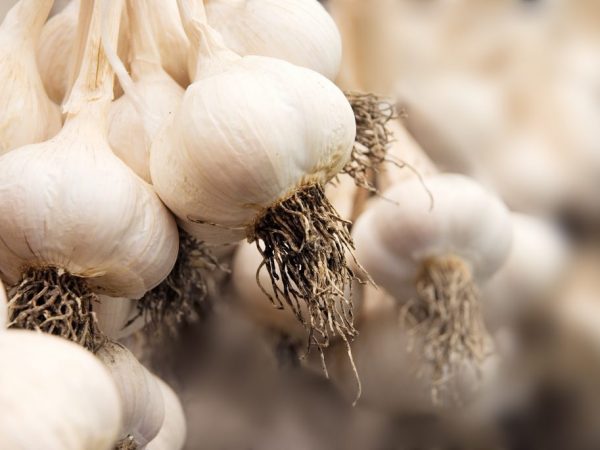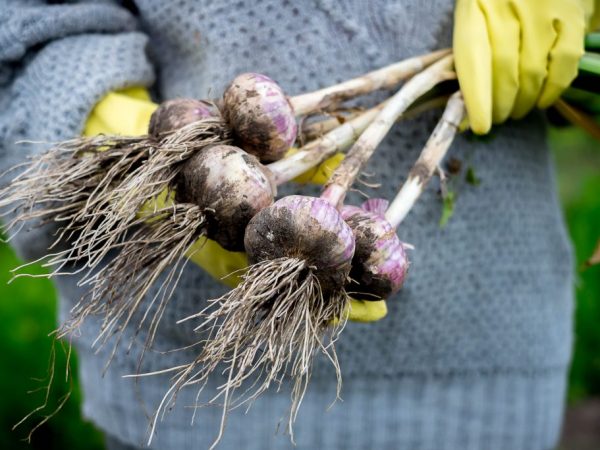Garlic harvesting rules in 2019
Vegetables are often harvested according to the lunar calendar. Collected in the waning moon are fresher and healthier, they are stored longer. Harvesting garlic in 2019 has a number of features that every gardener is recommended to observe.

Garlic harvesting rules in 2019
Collection time
The winter variety ripens 100 days after germination. Harvesting should be taking into account what type of garlic it belongs to. There are 2 types of vegetables:
- winter - planted in autumn (in September or October);
- spring - sown in spring.
Winter garlic is harvested in mid-July. Spring is usually harvested at the end of August. Harvesting is carried out on a warm day. You need to carefully monitor the tops: if it is not yet yellow, you should postpone the collection.
Moscow suburbs
In order for the crop to be stored for a long time and with high quality, you need to know the optimal harvest time. Planting time in 2019 is late fall. In the Moscow region, harvest this year should be at the end of July or early August. If the summer is hot, then you can do it earlier.
A sign of the ripening of garlic is the cracked surface of the inflorescences. This can be determined by noticing the yellowing of the plant.
It is recommended to harvest the vegetable in a timely manner, otherwise the integumentary membrane and the head may crack. In such a situation, immediately start drying and salting. After harvesting, the garlic is dried for several minutes, then placed in storage.
There are auspicious days for the harvest. Depending on which zodiac sign the moon is in, the timing for this is also determined. Thus, good days are:
- July 23-27;
- August 19-25;
- September 8, 9, 16, 21, 25, 26;
- October 3, 6, 15, 19, 22, 25.
Ripening time in the Moscow region may vary due to weather conditions and characteristics of the variety.
Ural

Digging out the garlic dry
Cleaning in the Urals is distinguished by several factors. A winter crop usually ripens 100 days after germination. The winter species in this area will ripen at the end of July. Spring ripens in September.
As with growing onions, you should stop watering the garden 2-3 weeks before picking the vegetable. Summer harvest is harvested after winter. Based on the recommendations of the lunar calendar, spring is harvested from August 20 to September 10.
In the South Urals, a summer variety is planted in the spring. The ripening of a vegetable can be determined by the leaves. Yellow and dried - indicates that the garlic is ready to be harvested.
Siberia
Vegetable harvesting in Siberia has certain peculiarities. The climate in this region is different from the rest. Winter is characterized by severe frosts, spring is considered fast, and summer is short. Harvesting in this region takes place towards the end of July or early August.
First, the garlic is dried, then collected and stored suspended until the trunks dry out.
Harvesting garlic prematurely in 2019 can result in an unripe crop. The teeth can become tasteless and smell damp. If you do this later than the due date, it can lead to the disclosure of the heads in the ground.
Harvesting in Siberia takes place a little later, in contrast to other regions.Due to the late arrival of spring, the harvest time is shifted. This leads to the fact that the vegetable cannot be stored for a long time.
Cleaning rules
Different types of garlic have their own assembly characteristics. Spring, which is considered to be summer, "gives signals" before the onset of ripening. Yellowed foliage indicates readiness for harvesting. Usually its term is the second half of August. Winter is considered a winter species. You can pick vegetables as soon as you notice a few signs:
- cracking of the surface of the inflorescences;
- yellowing of the lower leaves;
- drying of the scales of the bulbs.
The winter species is harvested at the end of July. If the vegetable shows signs of maturity, you need to immediately start harvesting. It should be carried out in dry and warm weather. It is not recommended to delay the collection of garlic. Late terms threaten to lower the quality of the product. There is a risk that it will be poorly stored.
An overripe crop is characterized by burst scales and division of the heads into denticles.
It is better not to leave a damaged bulb for storage. Harvesting is recommended with a pitchfork or a shovel. Then the vegetable is laid out to dry. The heads and roots are shaken off excess soil.
Drying and storage
Garlic is dried on sunny days for 5 days. If the weather is humid, this should be done in a well-ventilated place. In the daytime it is better to dry it under the sun, in the evening - to take it to a warm room. When the crop is dry, you need to prune the roots and stems.
Sort heads by size before storing. Spring is kept at a temperature of 16 to 20 ° C. Winter - from 2 to 4 ° C. Do not leave the vegetable in a damp place: the crop can be subject to various diseases.
It is better to store the vegetable in braids. They are woven from garlic like this: the onion and stem are left, and the leaves are removed. The end of the braid ends with a loop. It is better to store the crop in long bundles, nets, wicker baskets and wooden boxes.

